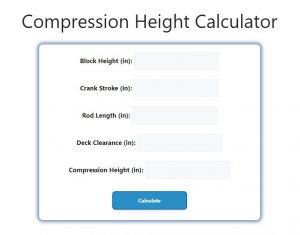About Compression Height Calculator (Formula)
A Compression Height Calculator is an essential tool for automotive engineers and enthusiasts looking to optimize engine performance. Compression height plays a crucial role in an engine’s efficiency, power output, and overall functionality. By calculating the compression height, users can ensure that the engine components are correctly aligned and that the engine operates smoothly. This article provides an overview of the compression height calculation, its formula, and practical applications.
Formula
The formula to calculate Compression Height (CH) is: Compression Height (CH) = Block Height (BH) – 0.5 * Crank Stroke (CS) – Rod Length (RL) – Deck Clearance (DC).
How to Use
Using the Compression Height Calculator is straightforward. Follow these steps:
- Gather Measurements: Obtain the following measurements:
- Block Height (BH): The height of the engine block.
- Crank Stroke (CS): The distance traveled by the piston from the bottom to the top of the cylinder.
- Rod Length (RL): The length of the connecting rod.
- Deck Clearance (DC): The space between the top of the piston and the engine block when the piston is at the top dead center.
- Input Values: Enter the gathered measurements into the calculator.
- Calculate: The calculator will apply the formula to provide the compression height (CH).
Example
Suppose you have the following measurements for an engine:
- Block Height (BH): 9.0 inches
- Crank Stroke (CS): 3.5 inches
- Rod Length (RL): 6.0 inches
- Deck Clearance (DC): 0.020 inches
To calculate the compression height:
- Block Height (BH): 9.0 inches
- Crank Stroke (CS): 3.5 inches
- Rod Length (RL): 6.0 inches
- Deck Clearance (DC): 0.020 inches
Now, apply the formula:
CH = 9.0 – 0.5 * 3.5 – 6.0 – 0.020
CH = 9.0 – 1.75 – 6.0 – 0.020
CH = 1.230 inches
Therefore, the compression height is approximately 1.230 inches.

FAQs
- What is compression height?
- Compression height is the distance from the centerline of the crankshaft to the top of the piston at the top dead center.
- Why is compression height important?
- It affects engine performance, combustion efficiency, and power output.
- What measurements do I need for the calculator?
- You need the block height, crank stroke, rod length, and deck clearance.
- How do I measure block height?
- Measure from the bottom of the engine block to the top surface where the cylinder head sits.
- What tools are needed for measuring?
- A caliper or a measuring tape can provide accurate measurements for engine components.
- How does crank stroke affect compression height?
- A larger crank stroke increases the distance the piston travels, impacting the overall compression height.
- What happens if compression height is incorrect?
- An incorrect compression height can lead to engine knocking, loss of power, or even engine failure.
- Can I use this calculator for any engine type?
- Yes, as long as you have the necessary measurements, the calculator can be used for various engine types.
- What is deck clearance?
- Deck clearance is the gap between the piston and the top of the engine block when the piston is at the top dead center.
- How can I improve engine performance?
- Adjusting compression height, along with other engine parameters, can enhance performance.
- Can I calculate compression height for custom engine builds?
- Yes, this calculator is particularly useful for custom builds where precise measurements are critical.
- How does rod length influence compression height?
- The length of the connecting rod directly impacts the position of the piston at top dead center.
- What is the ideal compression height?
- The ideal compression height varies based on engine design and performance goals; consult manufacturer specifications.
- Is there a limit to how high I can set compression height?
- Yes, exceeding recommended compression heights can lead to engine knock and other performance issues.
- Can compression height affect fuel type?
- Yes, higher compression ratios may require higher-octane fuels to prevent knocking.
- How can I measure deck clearance accurately?
- Use a feeler gauge to determine the gap between the piston and the deck surface.
- Are there specific tolerances for compression height?
- Yes, specific tolerances depend on engine design and manufacturer recommendations.
- How often should I check compression height?
- It’s good practice to check compression height whenever rebuilding or modifying an engine.
- Can I use a digital caliper for measurements?
- Yes, a digital caliper provides precise measurements for engine components.
- What should I do if I find discrepancies in my measurements?
- Re-check your measurements for accuracy and consult technical manuals for guidance if discrepancies arise.
Conclusion
The Compression Height Calculator is a vital tool for anyone involved in engine design and performance tuning. By accurately calculating compression height, users can optimize engine performance and ensure smooth operation. With the right measurements and understanding of the factors involved, automotive professionals and enthusiasts can achieve the best possible results for their engines.